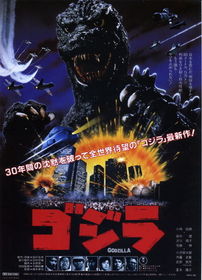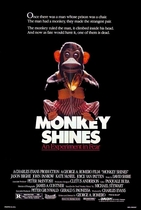Our editor-in-chief Nate Yapp is proud to have contributed to the new book Hidden Horror: A Celebration of 101 Underrated and Overlooked Fright Flicks, edited by Aaron Christensen. Another contributors include Anthony Timpone, B.J. Colangelo, Dave Alexander, Classic-Horror.com's own Robert C. Ring and John W. Bowen. Pick up a copy today from Amazon.com!
Godzilla 1985 (1985)
There is a word that is being bandied about more in the film community these days: re-imagining. Re-imagine a film and you hold on to the original idea but deck it out with just enough new elements to reel in new fans. Or more simply, a producer, out of fresh ideas, dusts off an old tried-and-true formula, tweaking things just enough to fool viewers into thinking they’re seeing something different. This is like a used car dealer who pours all the money they have into fixing the exterior an old classic while leaving the cracking vinyl seats alone and still trying to sell it as “like new”. Godzilla 1985 is a rebuilt version of that classic car, replete with cool, dark green paint and new spinning wheel rims. There’s an improved look to this film. Too bad the interior is still the same old and worn material.
The film's plot is fairly basic. A ship is destroyed at sea, apparently by nasty weather and violent waves. This coincides with a Godzilla sighting. An investigating reporter teams with the attack’s lone survivor, his sister, and Godzilla expert Dr. Hayashida, to devise a plan to stop the scaly menace. Japan tries to suppress news of the attack but, when the monster smashes a Russian sub, the U.S. is blamed by the Soviets and cold war tensions rise. While Godzilla stomps through Tokyo, the truth gets out and U.S. brings in reporter Steve Martin (Raymond Burr), who survived the attack 30 years ago, and they work with Japan to try and end the carnage.
With this entry, director Koji Hashimoto valiantly attempts to restore the Godzilla character and theme to the darker, nastier roots of the first two entries in the series, (the 1954 original and its immediate sequel Godzilla Raids Again from 1955), a contrast to the quasi-hero of later sequels who battled monsters and aliens to save his beloved Tokyo. When the switch was made to this kinder, gentler, almost huggable defender of Japan, the series lost much of that tone of the first two films and the symbolic meaning of what Godzilla represents. The monster’s creation is directly attributed to atomic bomb testing and the creature, itself, is a walking result of the dangers of said tests. The intent was to say that a future with nuclear weapons is a very bleak one for all concerned. Hashimoto returns to this outlook, making good use of night photography, dimly lit settings, and an often relentless editing pace. In a neat reversal in series formula, Hashimoto once again presents Godzilla as a marauding destroyer, killing dozens of innocents wantonly and seemingly bent on a bloody rampage. The opening ship attack and the main stomp through Tokyo, for example, are filmed in such a way that both reach an air of creepiness and dread not seen in years in the series. In addition, the film’s editing offers a frenetic energy in which the action is rarely allowed to let up. The military assault late in the film, led by an experimental craft called Super X, is so swiftly-paced as to be breathless.
The script for Godzilla 1985 does a nice job of echoing the darker themes with heavy subtext about political mistrust and the ever-present use of nuclear weapons, and does well to de-emphasize the humor found in previous sequels. There are no ridiculous comic sidekicks or unintentionally funny wrestling between giant monsters to impede on the action. What is here is a strong underlying theme about how mistrust between superpowers, coupled with a level of power enough to cause mutual annihilation, is a bigger monster than even Godzilla. There’s also a revisiting of the theme of nuclear bomb testing getting the blame for Godzilla’s resurrection. Throw in a couple of scenes detailing a “Whose government is to blame?”/Cold War-style thread between the U.S., Russia, and Japan, and you have a good, fairly ambitious story
What few positives the film has, however, are completely outweighed by key flaws. At the top of the list is the varying quality of the special effects. The opening ship attack makes effective use of models (though it’s still apparent that the model is inside a water tank), dim lighting, and a few judiciously-placed partial shots of Godzilla to create a tense scene. The later Tokyo trashing, however, resorts to more obvious models and the man-in-a-monster-suit Godzilla is in full focus, undermining any amount of suspense the scenes might generate. Seeing a man-in-a-suit monster stomping on toy buildings does more to provoke yawns than chills. Things get better with the assault against Godzilla led by the Super X craft. This sequence is well-handled, with good laser optical effects utilized, providing a flurry of visual treats for fans. Good special effects consistency is crucial for these type of films to both drawing fans in to the action and drawing them away from any script problems.
As to those script troubles, most of them come from the unbelievably silly dialogue written for the American footage added by New World Pictures. Raymond Burr is given dialogue that is little more than solemn, almost morose conciliation, calling Godzilla “a force of nature” and offering up several remarks on the futility of efforts to destroy the creature. Though there is some evidence in this film that the original script, minus the inserts, was much better, it does have a few silly bits as well that work against the dark tone. The whole Super X element, as exciting aesthetically as it is, does seem out of place and belonging to a different, more Star Wars-like film. Additionally, there is a plot device which figures in to the finale about Godzilla being drawn to the call of seagulls that strains logic somewhat. It is explained that dinosaurs evolved into birds and that Godzilla is drawn to their sound, but why seagulls, specifically, and not some other type of bird? There’s no explanation of Godzilla’s connection to gulls other than the coincidental fact that they were present when the first attack on the ship took place. This seems to be nothing more than a convenient story contrivance.
Finally, special dishonorable mention should go to New World Pictures for its first-year film school post-production editing job, specifically when it came to conceiving the idea of the insert footage in the first place and, secondly, the ham-handed way of editing in this new footage. The new footage adds nothing to the action and, in fact, seems to make the story feel a bit more clunky at times. Just when the suspense starts to build, viewers are treated to static scenes with seeming redneck military types pensively moving about and uttering bad dialogue about how the Russians will react. Additionally, the tone of the inserts is different enough from the original Japanese version that there never seems to be a moment where the added scenes don’t feel like they come from a different movie, in spite of any linking dialogue.
Fellow viewers, as you drive to the movie theater in your metallic green classic convertible, sitting on your torn leather seats, amuse yourself by re-imagining what film producers in any country could do if they had originality, creativity, a good editor, and a budget that offers consistently good effects? Chances are, you’ll be re-imagining something other than Godzilla 1985.
Part of Godzilla Week, a crossover event with The Sci-Fi Block. Read the SFB review of Godzilla 1985.









This is a really outstanding
This is a really outstanding review. I wonder why Godzilla movies are always so flawed, especially when they're made by different people. They really shouldn't have made more than one, and that one should have been a lot better than it was. I can't imagine why they ever used Raymond Burr in the first place. He should have been the fellow in the Godzilla suit.
Hi Kevin,an excellent review
Hi Kevin,
an excellent review !
I think you cannot emphasize enough that Godzilla 1985 is the bastard child of New World Pictures and Godzilla 1984, a very different film indeed. The latter is much darker, has a more coherent plot, no Raymond Burr, more special effects scenes (some of the best were edited out of the US version), and even a logical reason why Godzilla follows the birds.
G-Fan has run some insightful articles and interviews over the years as to why the film was butchered for the stateside release. http://www.g-fan.com/
Best regards,
--Volker
Volker,Thanks for your
Volker,
Thanks for your comment. As part of our Godzilla week event, Classic-Horror posted a review of Godzilla 1985 (the American cut) and Sci-Fi Block posted a review of the uncut Japanese version (which I actually wrote myself). Never let it be said that we can't see both sides of an issue. *cymbal crash*
"He went for a little walk! You should have seen his face!"
Thanks, Volker, Nate, and
Thanks, Volker, Nate, and Auggie. I thought there was possibly an interesting film at the core before the US distributors butchered the crap out of it. I think I just may have to seek out the uncut Japanese version and give it a view.
Kevin
Kevin Nickelson "Suffering!? Sometimes I wonder if you know the meaning of the word!" (Peter Cushing-"House of Long Shadows"/1982)